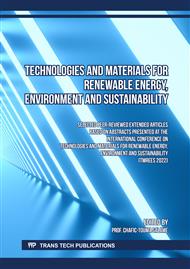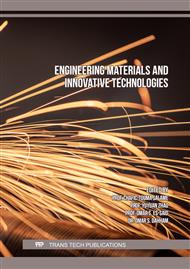[1]
Simonson CJ, Salonvaara M, Ojanen T. The effect of structures on indoor humidity - Possibility to improve comfort and perceived air quality. Indoor Air 2002;12:243–51. https://doi.org/10.1034/j.1600-0668.2002.01128.x.
DOI: 10.1034/j.1600-0668.2002.01128.x
Google Scholar
[2]
Bahar R, Benazzoug M, Kenai S. Performance of compacted cement-stabilised soil. Cem Concr Compos 2004;26:811–20. https://doi.org/10.1016/j.cemconcomp.2004.01.003.
DOI: 10.1016/j.cemconcomp.2004.01.003
Google Scholar
[3]
Morel JC, Mesbah A, Oggero M, Walker P. Building houses with local materials: Means to drastically reduce the environmental impact of construction. Build Environ 2001;36:1119–26. https://doi.org/10.1016/S0360-1323(00)00054-8.
DOI: 10.1016/s0360-1323(00)00054-8
Google Scholar
[4]
Aymerich F, Fenu L, Meloni P. Effect of reinforcing wool fibres on fracture and energy absorption properties of an earthen material. Constr Build Mater 2012;27:66–72. https://doi.org/10.1016/j.conbuildmat.2011.08.008.
DOI: 10.1016/j.conbuildmat.2011.08.008
Google Scholar
[5]
Danso H, Martinson B, Ali M, Mant C. Performance characteristics of enhanced soil blocks: A quantitative review. Build Res Inf 2015; 43: 253–62. https://doi.org/10.1080/09613218.2014. 933293.
DOI: 10.1080/09613218.2014.933293
Google Scholar
[6]
Millogo Y, Morel JC, Aubert JE, Ghavami K. Experimental analysis of Pressed Adobe Blocks reinforced with Hibiscus cannabinus fibers. Constr Build Mater 2014;52:71–8. https://doi.org/10.1016/J.CONBUILDMAT.2013.10.094.
DOI: 10.1016/j.conbuildmat.2013.10.094
Google Scholar
[7]
Laborel-Préneron A, Magniont C, Aubert JE. Hygrothermal properties of unfired earth bricks: Effect of barley straw, hemp shiv and corn cob addition. Energy Build 2018;178:265–78. https://doi.org/10.1016/j.enbuild.2018.08.021.
DOI: 10.1016/j.enbuild.2018.08.021
Google Scholar
[8]
Hamard E, Cammas C, Lemercier B, Cazacliu B, Morel JC. Micromorphological description of vernacular cob process and comparison with rammed earth. Front Archit Res 2020;9:203–15. https://doi.org/10.1016/j.foar.2019.06.007.
DOI: 10.1016/j.foar.2019.06.007
Google Scholar
[9]
Babé C, Kidmo DK, Tom A, Mvondo RRN, Boum RBE, Djongyang N. Thermomechanical characterization and durability of adobes reinforced with millet waste fibers (sorghum bicolor). Case Stud Constr Mater 2020;13:e00422. https://doi.org/10.1016/j.cscm.2020.e00422.
DOI: 10.1016/j.cscm.2020.e00422
Google Scholar
[10]
Mazhoud B, Collet F, Prétot S, Lanos C. Effect of hemp content and clay stabilization on hygric and thermal properties of hemp-clay composites. Constr Build Mater 2021;300:123878. https://doi.org/10.1016/j.conbuildmat.2021.123878.
DOI: 10.1016/j.conbuildmat.2021.123878
Google Scholar
[11]
Saidi M, Cherif AS, Zeghmati B, Sediki E. Stabilization effects on the thermal conductivity and sorption behavior of earth bricks. Constr Build Mater 2018;167:566–77. https://doi.org/10.1016/j.conbuildmat.2018.02.063.
DOI: 10.1016/j.conbuildmat.2018.02.063
Google Scholar
[12]
Baroghel-Bouny V. Water vapour sorption experiments on hardened cementitious materials. Part I: Essential tool for analysis of hygral behaviour and its relation to pore structure. Cem Concr Res 2007;37:414–37. https://doi.org/10.1016/j.cemconres.2006.11.019.
DOI: 10.1016/j.cemconres.2006.11.019
Google Scholar
[13]
Zhang X, Zillig W, Künzel HM, Zhang X, Mitterer C. Evaluation of moisture sorption models and modi fi ed Mualem model for prediction of desorption isotherm for wood materials. Build Environ 2015;92:387–95. https://doi.org/10.1016/j.buildenv.2015.05.021.
DOI: 10.1016/j.buildenv.2015.05.021
Google Scholar
[14]
Collet F, Chamoin J, Pretot S, Lanos C. Comparison of the hygric behaviour of three hemp concretes. Energy Build 2013;62:294–303. https://doi.org/10.1016/j.enbuild.2013.03.010.
DOI: 10.1016/j.enbuild.2013.03.010
Google Scholar
[15]
Cagnon H, Aubert JE, Coutand M, Magniont C. Hygrothermal properties of earth bricks. Energy Build 2014;80:208–17. https://doi.org/10.1016/j.enbuild.2014.05.024.
DOI: 10.1016/j.enbuild.2014.05.024
Google Scholar
[16]
Hamard E, Morel J, Salgado F, Marcom A, Meunier N. Original article A procedure to assess the suitability of plaster to protect vernacular earthen architecture. J Cult Herit 2013;14:109–15. https://doi.org/10.1016/j.culher.2012.04.005.
DOI: 10.1016/j.culher.2012.04.005
Google Scholar
[17]
Shahabadi SZ, Harofteh MA, Shahabadi AZ. Technology in Society Relationship of economic and environmental factors with the acceptance of earthen architecture technology : A case study of young educated couples in. Technol Soc 2019;59:101152. https://doi.org/10.1016/j.techsoc.2019.101152.
DOI: 10.1016/j.techsoc.2019.101152
Google Scholar
[18]
Sirinwaranon P, Atong D, Sricharoenchaikul V. Gasification of torrefied cassava rhizome with Ni/MCM-41 catalyst derived from illite waste. Energy Reports 2020;6:537–47. https://doi.org/10.1016/j.egyr.2020.09.031.
DOI: 10.1016/j.egyr.2020.09.031
Google Scholar
[19]
Lagouin M, Magniont C, Sénéchal P, Moonen P, Aubert J. Influence of types of binder and plant aggregates on hygrothermal and mechanical properties of vegetal concretes 2019;222:852–71. https://doi.org/10.1016/j.conbuildmat.2019.06.004.
DOI: 10.1016/j.conbuildmat.2019.06.004
Google Scholar
[20]
Riaz M, Chen B. Influence of type of binder and size of plant aggregate on the hygrothermal properties of bio-concrete. Constr Build Mater 2020;251:118981. https://doi.org/10.1016/j.conbuildmat.2020.118981.
DOI: 10.1016/j.conbuildmat.2020.118981
Google Scholar
[21]
McGregor F, Heath A, Shea A, Lawrence M. The moisture buffering capacity of unfired clay masonry. Build Environ 2014;82:599–607. https://doi.org/10.1016/j.buildenv.2014.09.027.
DOI: 10.1016/j.buildenv.2014.09.027
Google Scholar
[22]
Haba B, Agoudjil B, Boudenne A, Benzarti K. Hygric properties and thermal conductivity of a new insulation material for building based on date palm concrete. Constr Build Mater 2017;154:963–71. https://doi.org/10.1016/j.conbuildmat.2017.08.025.
DOI: 10.1016/j.conbuildmat.2017.08.025
Google Scholar
[23]
Remki B, Abahri K, Belarbi R, Bensaibi M. Hydric and structural approaches for earth based materials characterization. Energy Procedia 2017;139:417–23. https://doi.org/10.1016/j.egypro. 2017.11.231.
DOI: 10.1016/j.egypro.2017.11.231
Google Scholar
[24]
Liuzzi S, Rubino C, Stefanizzi P, Petrella A, Boghetich A, Casavola C, et al. Hygrothermal properties of clayey plasters with olive fibers. Constr Build Mater 2018;158:24–32. https://doi.org/10.1016/j.conbuildmat.2017.10.013.
DOI: 10.1016/j.conbuildmat.2017.11.117
Google Scholar
[25]
Liuzzi S, Rubino C, Martellotta F. Properties of clay plasters with olive fibers. LTD; 2020. https://doi.org/10.1016/B978-0-12-819481-2.00009-X.
DOI: 10.1016/b978-0-12-819481-2.00009-x
Google Scholar
[26]
Rahim M, Douzane O, Le ADT, Promis G, Langlet T. Characterization and comparison of hygric properties of rape straw concrete and hemp concrete 2016;102:679–87. https://doi.org/10.1016/j.conbuildmat.2015.11.021.
DOI: 10.1016/j.conbuildmat.2015.11.021
Google Scholar
[27]
Fouchal F, Gouny F, Maillard P, Ulmet L, Rossignol S. Experimental evaluation of hydric performances of masonry walls made of earth bricks, geopolymer and wooden frame. Build Environ 2015;87:234–43. https://doi.org/10.1016/j.buildenv.2015.01.036.
DOI: 10.1016/j.buildenv.2015.01.036
Google Scholar
[28]
Hall M, Allinson D. Analysis of the hygrothermal functional properties of stabilised rammed earth materials. Build Environ 2009;44:1935–42. https://doi.org/10.1016/j.buildenv.2009.01.007.
DOI: 10.1016/j.buildenv.2009.01.007
Google Scholar
[29]
El Fgaier F, Lafhaj Z, Chapiseau C, Antczak E. Effect of sorption capacity on thermo-mechanical properties of unfired clay bricks. J Build Eng 2016;6:86–92. https://doi.org/10.1016/j.jobe.2016.02.011.
DOI: 10.1016/j.jobe.2016.02.011
Google Scholar
[30]
Fabbri A, Mcgregor F, Costa I, Faria P. Effect of temperature on the sorption curves of earthen materials. Mater Struct 2017;50:1–13. https://doi.org/10.1617/s11527-017-1122-7.
DOI: 10.1617/s11527-017-1122-7
Google Scholar
[31]
Champiré F, Fabbri A, Morel JC, Wong H, McGregor F. Impact of relative humidity on the mechanical behavior of compacted earth as a building material. Constr Build Mater 2016;110:70–8. https://doi.org/10.1016/j.conbuildmat.2016.01.027.
DOI: 10.1016/j.conbuildmat.2016.01.027
Google Scholar
[32]
Zhang X, Zillig W, Künzel HM, Zhang X, Mitterer C. Evaluation of moisture sorption models and modified Mualem model for prediction of desorption isotherm for wood materials. Build Environ 2015;92:387–95. https://doi.org/10.1016/j.buildenv.2015.05.021.
DOI: 10.1016/j.buildenv.2015.05.021
Google Scholar
[33]
Muzaffar K, Kumar P. Moisture sorption isotherms and storage study of spray dried tamarind pulp powder. Powder Technol 2016;291:322–7. https://doi.org/10.1016/j.powtec.2015.12.046.
DOI: 10.1016/j.powtec.2015.12.046
Google Scholar
[34]
Tchouanti B, Onguene P, Ali A, Mouangue R. Effect of particle size on syngas production using sawdust of Cameroonian Triplochiton scleroxylon 2019;6. https://doi.org/10.1016/j.sciaf.2019.e00182.
DOI: 10.1016/j.sciaf.2019.e00182
Google Scholar
[35]
Césaire A, Noubissié E, Carly S, Desobgo Z, Ali A. Optimization of the enzymatic hydrolysis of cellulose of triplochiton scleroxylon sawdust in view of the production of bioethanol 2020;8. https://doi.org/10.1016/j.sciaf.2020.e00438.
DOI: 10.1016/j.sciaf.2020.e00438
Google Scholar
[36]
Touré PM, Sambou V, Faye M, Thiam A, Adj M, Azilinon D. Mechanical and hygrothermal properties of compressed stabilized earth bricks (CSEB). J Build Eng 2017;13:266–71. https://doi.org/10.1016/J.JOBE.2017.08.012.
DOI: 10.1016/j.jobe.2017.08.012
Google Scholar



